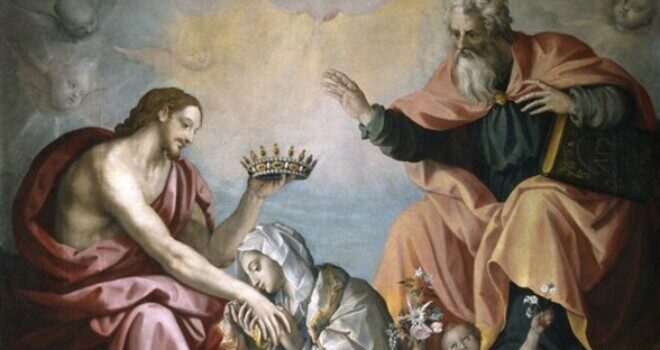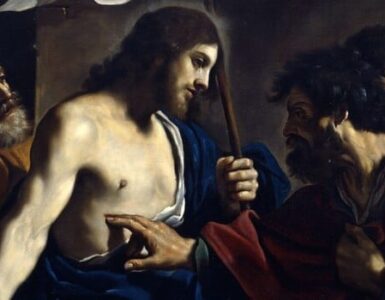Author’s Note: In this commentary on John 19:25-27, Don Dolindo Ruotolo reflects on the spiritual significance of Jesus entrusting His mother to John at the foot of the cross. He sees in this act the establishment of Mary’s universal motherhood over the Church and all humanity. Don Dolindo emphasizes that devotion to Mary, far from detracting from Jesus, is essential for drawing closer to Him and the sources of sanctity. He exhorts the faithful to imitate John by welcoming Mary into their hearts, consecrating their lives to her, and allowing her to lead them to Jesus.
Suspended by three nails, writhing in unspeakable anguish, all wounds, with a body reduced to extreme impotence, agonizing, Jesus faced the infernal forces, and defeated them with His obedience, with His humiliation, and with His love.
Satanic pride felt itself weakening, couldn’t take it, the one that had said non serviam (“we will not serve”), in the face of that complete obedience, which wasn’t fulfilled amidst ecstatic joys of love, but in extreme abandonment and extreme humiliation. That act of obedience was divine; Satan felt the divine superiority, was confused, felt in that light all the horror of his guilt, was ashamed of the dark kingdom of which he boasted, yielded, sank with his satellites, down, down into the horrible darkness of his dark spirit! For the first time, he understood that he was not light, that he was not a ruler, that he was not a king, and for the first time, he measured the narrowness of his kingdom of ruins in proportion to his spirit always tense towards the limitless boundaries of the Infinite!
What a moment! Jesus was gasping; His eyes were veiled by agony, He was covered in the hatred of all the wicked, but He was spreading love. Satan, the spirit of hatred, was crushed. Father, forgive them, for they do not know what they are doing; Satan heard it, and instantly saw an open gap in the flood of hatred, which he had poured onto the earth. He was defeated by merciful love, and then saw one of the condemned thieves escape, on whom he had already set his hooked claws. He trembled at that word of love: Remember me, trembled at hearing: Today you will be with me in Paradise. So, Paradise, which he believed he had closed forever to humanity, was opening up.
He saw at the foot of the cross the Mother of his defeat: it was the Immaculate One, who had never been under his divine dominion, and it was the final blow. He was enraged to hear her called the Universal Mother: Mary was the Queen of the world, shining like a bright star, was a light of love, because like a shining mirror of justice, she gathered all the rays of the mercy of the Divine Victim. And Jesus was struggling amidst the darkness of the heavy atmosphere and the darkness of His anguished Heart…He was struggling alone, alone, abandoned by the Father, but in that abandonment, He gave the greatest testimony of love, burning with thirst, with love for Him and for souls…Satan stood as if stunned; once again, he was defeated, and as soon as Jesus’ divine soul, in a final cry of love, separated from His body, he, as if annihilated by lightning, sank into the depths, making the earth tremble. Love had won!
This was His victory, a magnificent victory, because sin was atoned for, justice was satisfied, the kingdom of evil was annihilated forever, and from then on, century by century, it would dissolve, until the final judgment, in which the Crucified One, glorious and triumphant, would forever relegate it to Hell.
On Calvary stood the pious women who, weeping, had followed Jesus to the place of execution. At first, they had to keep their distance, as the other evangelists say, because the soldiers wouldn’t let them approach the cross; but when the sky grew dark and fear spread among those on Golgotha, they became bolder and drew closer. The soldiers, on the other hand, having completed their sad task, didn’t stop them because, after the initial surge of curiosity among the crowd that had gathered for the crucifixion as if it were a spectacle, as Saint Luke puts it (23:48), a certain calm had settled on the mountain.
Saint John lists the main women who stood by the cross; first and foremost, Mary Most Holy, Mother of the Redeemer, and her sister, that is, a relative, Mary, wife of Cleophas, and Mary Magdalene, the sinner who had been converted by Jesus. There were also other pious women, but these three stood right by the cross. They represented all women: Mary, the virgins; Mary of Cleophas, the married women; Mary Magdalene, the penitents. Mary Most Holy, Immaculate Virgin, and the opposite pole, Mary Magdalene, penitent sinner—between these two extremes, Mary of Cleophas.
They stood motionless, as if petrified by grief, with their gaze fixed on Jesus to follow His agony, and with their hearts torn apart by an unspeakable anguish.
Mary Most Holy was there and prayed for the souls of all centuries, uniting herself to the sacrifice of her Son. She was Co-Redemptrix and fulfilled this noblest of offices by imploring mercy for sinners. Now Jesus, seeing His Mother, and near her the beloved disciple, said to His Mother: Woman, behold your son. He saw His Mother not only with an external gaze but with an internal one; He saw her as His Mother in that moment when He represented all sinful humanity; He saw her as the woman, the new Eve, the Mother of all the living, and since He was King in His immolation, He saw her as Queen of the universe. Therefore, He called her “woman” and not Mother. Woman was equivalent to most noble lady, and it was a term of respect among the Jews; however, Jesus called His Mother thus for a greater reason, and regarded her as Lady and Queen of the redeemed, constituting her their mother.
Amidst His spasms, He loved, loved immensely, humanity, and His love wanted to assign them a divine Mother, so that through her they might have easier access to the treasures He was bestowing by redeeming them. This is the literal meaning of Jesus’ solemn words; we do not hesitate to assert it; this is what He primarily intended to say by entrusting John to Mary. To think that He simply wanted to give Mary a refuge in the home of a beloved disciple, or to him a companion and help, does not respond to the evangelical text and context.
Jesus first turned to Mary, saying to her, pointing to John: Behold, your son. If He had wanted to give her support and comfort in John, logically He would have first turned to John, telling him to regard her as Mother and provide for her as such. Mary wouldn’t have needed that because she already had a home or a welcoming place since Jesus took leave of her to begin His public ministry.
He assigned Mary as mother to John, and added, turning to the disciple, Behold, your Mother. He did this so that John would recognize, honor, and love her as such. John was young, had a profession as a fisherman that he still practiced, had a home and a brother, James; he wasn’t a destitute or abandoned person that Jesus wanted to entrust to His Mother for material care. It’s evident, therefore, that there’s an immensely greater purpose in those words: Behold, your son…Behold, your Mother…and perhaps that’s why, besides addressing Mary with an expression of honor, He called her woman and not Mother.
What a sublime mystery was hidden in those words of Jesus, simple and operative like those of consecration!
He on the cross formed His Church, and from His open Heart gave her life, just as from the open side of Adam, woman was formed. Mary, who had given Jesus His real Body, had to give Him His mystical Body as well, and He therefore constituted her Mother of all the redeemed, Mother of the priesthood in a most particular way, and Mother of the Church.
John was certainly the first beloved son of Mary; the first to recognize her as mother and be most devoted to her, but he was not the only direct son, so to speak, of Mary, nor was his adoptive filiation only a symbol of that of humanity; instead, he represented them all, and Jesus’ word referred to Mary’s universal motherhood. It’s a truth, we repeat, that clearly results from the evangelical text and context, and makes us feel present on Calvary at the foot of the cross and at the foot of Mother Mary.
The gift of His Mother that Jesus bestowed upon us, after giving Himself entirely, has not been fully understood and appreciated by mankind. The evil influence of sects, which are separated from the Mystical Body of Jesus and also from the Most Holy Mary, has increasingly pervaded the hearts of Christians, especially in modern times, leading to a waning devotion to Mary. There is a tendency to diminish this devotion more and more, almost as if to avoid offending heretics, and there is a fear of potentially dishonoring Jesus by honoring His Most Holy Mother, without considering that one cannot go to Jesus if one does not go to Mary.
Yet the Church always lives in the warmth of Mary’s maternal Heart, and the Church fathers and doctors have produced marvelous flourishes of praise, hymns, and acts of filial love for this sweetest of Mothers. Their speech, indeed, appears bold, so vivid and pulsing with faith. The world will not find peace and will not see the full triumph of Jesus without first seeing the triumph and reign of Mary. The triumph of Jesus will be like a renewal and a rebirth of His redemptive work, and since He began it precisely through Mary, He will renew it through Mary. It is a historically established fact that the greatest saints, in every era of the Church, have always been the greatest devotees of Mary; this is a most certain sign that such devotion, far from distancing us from God or the Redeemer, brings us closer to the very sources of sanctity.
Let us imitate Saint John, who, having received Mary as Mother, accepted her into his home. Let us make her dwell in our soul, declare her Queen of our activities, consecrate our life to her so that she may renew and restore it to the Lord. Let us pass everything through her hands, so that everything may be consecrated and blessed by her, and we, under her maternal mantle, may present ourselves with greater confidence to the throne and tribunal of Jesus Christ.
Editor’s Note: This passage was translated from Italian to English by Elie G. Dib.
Author’s Note: If you would like to read more about Don Dolindo’s spirituality, check out this book: Don Dolindo’s Spiritual Guidance.
Allori, A. (1593). Coronation of the Virgin [painting]. Retrieved from Galleria Dell’Accademia di Firenze.
Ruotolo, D. D. (1939). Commento alla Sacra Scrittura. Apostolato Stampa, 33.











